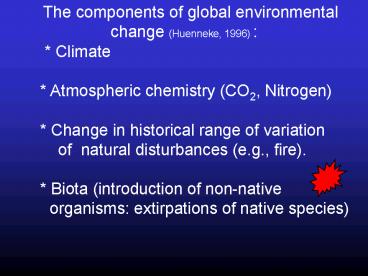The components of global environmental change Huenneke, 1996 : PowerPoint PPT Presentation
1 / 39
Title: The components of global environmental change Huenneke, 1996 :
1
The components of global environmental change
(Huenneke, 1996) Climate
Atmospheric chemistry (CO2, Nitrogen)
Change in historical range of
variation of natural disturbances
(e.g., fire). Biota (introduction of
non-native organisms
extirpations of native species)
2
(No Transcript)
3
Reasons for threatened species (Wilcove et al.
1998) Habitat destruction 85 Alien Species
49 Pollution
24 Overexploitation 17 Disease
3 (sum gt 100 because categories
are nonexclusive.)
4
Vitousek et al. 1997
5
The threat of species extinctions
Species lost to habitat destruction
?
6
Community vulnerability to invasion
(Mack et al. 2000) 1. Vacant
niches 2. Lack of biotic controls for invader 3.
Community species richness (Elton 1958)
The Ecology of Invasions by Animals and
Plants. 4. Disturbance (natural or
anthropogenic)
7
OikosOctober 2000 Plant diversity increases
resistance to invasion in the absence of
covarying extrinsic factors Shahid Naeem,
Johannes M. H. Knops, David Tilman, Katherine M.
Howe, Theodore Kennedy and Samuel
Gale Biodiversity loss within a community can
lower its resistance to invasion.
8
If vacant niches or lack of biotic diversity
was the reason explaining the appearance of more
non-native species What would you predict the
relationship Between native species richness and
non-native species richness might be?
Non-native Species richness
?
Native species richness
9
Hypothesis Native biodiversity inhibits
invasions by new species
Non-native Species richness
Native species richness
10
Grazing and Invasion
11
and diversity!
Higher nitrogen
Lower nitrogen
-
Smith and Knapp
12
Long-term Dynamics (Smith and Knapp, unpublished)
13
Effects of fires on exotic species on Konza
Prairie (disturbance is good???)
14
A plot of native nonnative abundances
15
Dr. David Buckner
Rich, bottomland soils
Old, upland soils
Abundance of weedy species in Boulder area
16
Small plot studies show that local species
richness can reduce introduction by new
species Watershed scale studies and larger show
that the number of non-native species increases
as the number of native species increases Can
you explain the apparent contradiction in
findings?
17
(No Transcript)
18
Within a small (homogeneous) area, high native
species richness can reduce non-native
richness. However, over Landscape scales,
factors that contribute to native richness also
contribute to non- Native richness
19
Jonathan Levine we found little evidence that
species interactions completely repelled
invasions. We conclude that ecological
interactions rarely enable communities to resist
invasion, but instead constrain the abundance of
invasive species once they have successfully
established.
20
If ecologists are to provide managers with
relevant information, they must be able to
understand and interpret their findings within
the context of the managers interests and
concerns. The message maintain native
biodiversity and youll reduce or prevent
invasions is unlikely to be good advice! The
message here appears to be, maintain those
extrinsic factors that are known to have
negative effects on invaders. Find the
strongest mechanisms that reduce resource
availability. These mechanisms may also have
negative effects on certain native species!
21
Native species
Introduced species
Regional species pool
Environmental filter
Biotic filter
Community
22
Craig et al. 1996
23
By 2005, the story that invaders are major
threats to biodiversity were dispelled.
24
(No Transcript)
25
Spread to New areas
Dominance across much of its range
Local establishment
Arrival of species
widespread
Widespread And dominant
26
transported
lost
introduced
failed
established
Objects of study
Noninvasive Invasive
27
Spotted knapweed
Wicked Weed of the West J. Alper, Smithsonian
Magazine, Dec. 2004
http//www.invasive.org/weeds/knapweed/images/Figu
re4_spotted_map.jpg
28
Since 2004, knapweeds (species of the genus
Centaurea) have been identified in the
literature as allelopathic
or not allelopathic aggressive
competitor or average
competitor sensitive to soil nutrients or
insensitive to soil nutrients stimulated
by herbivory or suppressed by
herbivory
29
The super invaders!
Allelopathy as an Ecological factor some
exotics transform from native weaklings to
invasive bullies by exuding biochemicals that
are highly inhibitory (allelopathic) to plants
or soil microbes in invaded communities.
Callaway and Ridenour 2004
30
Nicebut still fuzzy because
31
Uncertainty/controversy in bottom-up
controls An aggressive competitor (?)
strong competitor for soil resources
strong non resource competitor via
allelopathic abilities
Dominance by Diffuse Spotted knapweed
Plant competition
Mycorrhizae, free living microbes
(coevolution to soil chemistry?)
Soil resources
32
(No Transcript)
33
Raptors, Other mammals
chickadees
knapweed
Urophora flies
Deer mice
spiders
Hantavirus, Plague, Fleas, Rattlesnakes
Eat competing plant species
a non-native plant teams with a non-native
insect and native mouse to create havoc
34
Outcome of herbivory controlled By resource
availability
High resources
Any herbivory negative
Moderate resources
- Low resources
35
diffuse
36
When only one variable (e.g., herbivory,
resources, competition, allelopathy, etc.) is
under study, results can only be extrapolated to
those field conditions that match the
experiment.
Factorial experiments under controlled and field
conditions are used to Identify the range of
conditions in which a variable has control
potential.
37
Seed experiments indicate it takes about 1500
seeds to produce 1 flowering plant.
Seeds produced per square meter
1997
2008 year
38
C. stoebes ability to invade is a function of
plant competition
(Pokorney et al. 2005)
39
- Abundant immigrant plants
- (alias alien invaders)
- Can become unusually abundant because they
- lack top down controls (herbivory and
pathogens) - that exist in their native lands.
- b) They also may become unusually strong
competitors due - to non-coevolved positive soil feedbacks
with microbes - c) Allelopathy (toxic effects on other plants)is
usually a - minor issue, may in fact be a microbial
processand is - subject to coevolutionary modification (i.e.,
transient!)

